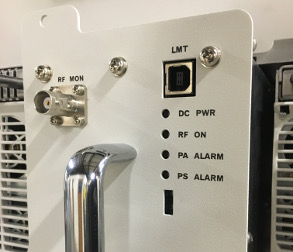Doherty Solid-State Power Amplifiers for ATSC 3.0 & OFDM
SOUTHWICK, MASS.—Hitachi Kokusai Electric Comark LLC has a long standing history in the broadcast TV market. Comark started more than 40 years ago manufacturing RF components for UHF transmitters and branched out to design and deliver full TV transmission systems. Hitachi-Comark has been involved in many innovations that have revolutionized the market. It is the only transmitter manufacturer to win multiple technical Emmy awards including for the Klystrode tube transmitter and for Digital Modular Adaptive Precorrection (DAP).
Over the last 18-24 months Hitachi-Comark has been preparing for the upcoming FCC spectrum auction and UHF channel re-pack with a full portfolio of equipment and services. For DTV transmitters, Hitachi-Comark and its sister organization Hitachi Kokusai Linear have introduced two highly efficient Doherty solid state UHF transmitter designs; PARALLAX and E-Compact. These solid state technologies perfectly complement the company’s market leading DCX Paragon MSDC-IOT transmitters.
So why is there an industry wide push towards Doherty? The answer is two-fold. First, Doherty amplifiers are more efficient than Class AB amplifiers. Doherty achieves higher efficiency by using LDMOS devices biased in both Class AB (carrier amp) and Class C (peaking amp). The Class AB device amplifies the average power level and the Class C device amplifies just the peaks of the digital waveform. Driving the Class AB device higher towards saturation improves efficiency; having the Class C complements the power amplifier with ample peak power capability to avoid signal compression and other non-linear distortions.

PA module from Hitachi Kokusai Electric Comark’s Parallax transmitter
The second reason Doherty is gaining popularity is that a properly designed Doherty amplifier can achieve equal power ratings in both ATSC 1.0 (8-VSB) and ATSC 3.0 (ODFM). Amplifiers are peak power limited. ATSC 1.0 has a peak to average power ratio between 6-7dB. So a 25kW transmitter (measured in average power) has to accommodate peaks that are in excess of 100kW! Amplifier requirements for ATSC 3.0 are even more onerous. OFDM has a typical peak to average ratio of 10dB. So that same 25kW transmitter (also measured in average power) has to accommodate peaks of 250kW! A typical amplifier needs to be de-rated by 15-20 percent when switching from ATSC 1.0 to ATSC 3.0; 25kW will be de-rated to ~20kW. Properly designed Doherty amplifiers, like those used in the PARALLAX, contain ample Class C peaking amplifier capacity. This allows equal average power rating in both ATSC 1.0 and ATSC 3.0, preserving investment now for use tomorrow.
ATSC 3.0 and FCC re-packing will cross paths during the next few years and Hitachi-Comark has been working hard to deliver products and technologies that are on point and ready for deployments. After involvement with live ATSC 3.0 demos at the CES and NAB shows last year, Hitachi-Comark released the EXACT-ATSC exciter. EXACT features “DualCast” technology that is easily upgraded via firmware from ATSC 1.0 to 3.0; protecting investment today for use tomorrow. The EXACT-ATSC exciter was even used in the Sinclair/ONE Media ATSC 3.0/SFN trial in the Baltimore-Washington DC trial that began in March of this year. And Hitachi-Comark is hard at work on other key ATSC 3.0 building blocks that will be simple to use yet take advantage of the powerful capabilities of ATSC 3.0.
Visit www.comarktv.com to learn more about Hitachi-Comark and its RF technology and associated products.
Joe Turbolski is Director of Sales Operations at Comark Communications.
Get the TV Tech Newsletter
The professional video industry's #1 source for news, trends and product and tech information. Sign up below.
